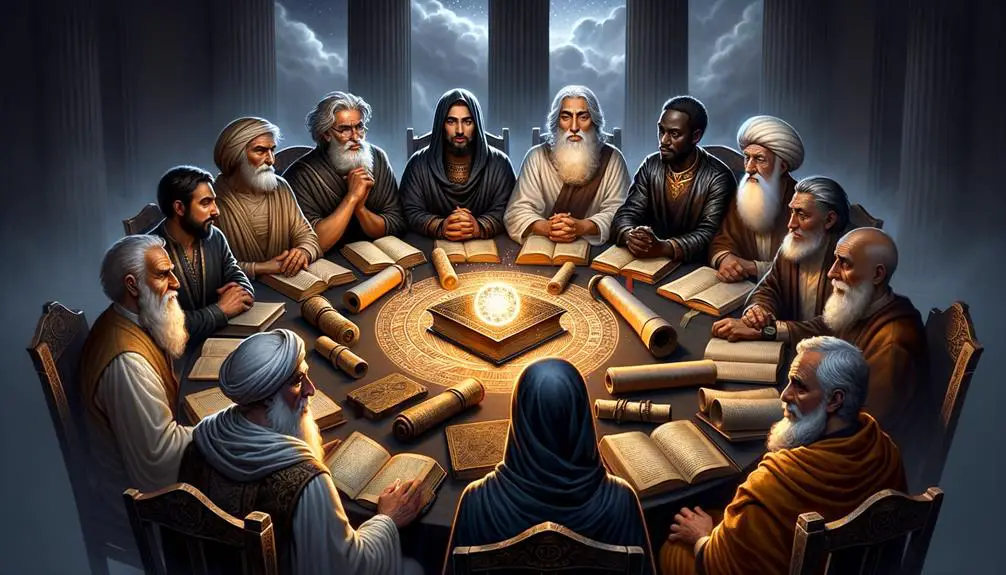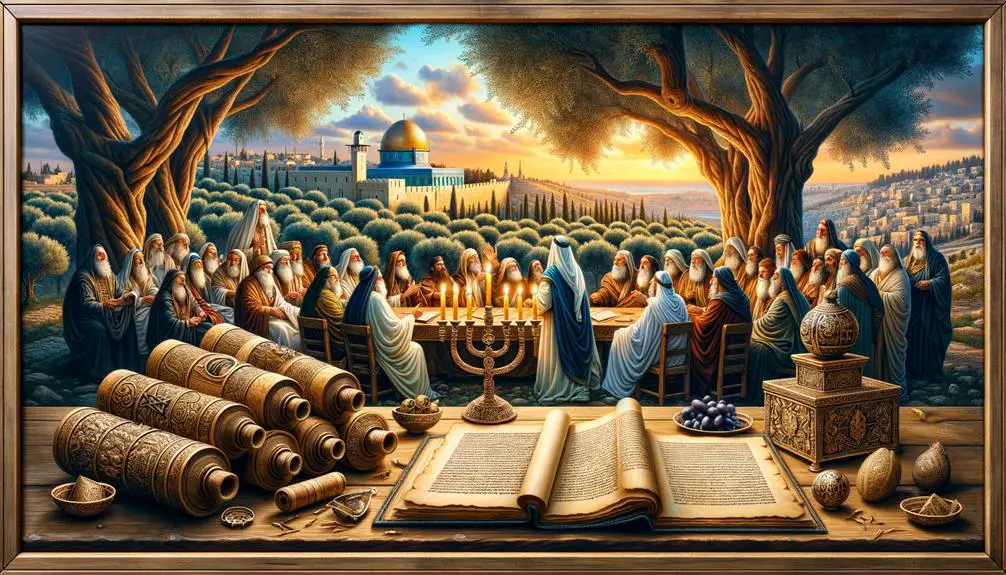Journey into the historical decisions and debates that shaped the Bible's contents, revealing a complex process of selection and controversy.

Who Decided What Books Are in the Bible
Have you ever wondered who had the authority to decide which books made it into the Bible? It's a question that has puzzled scholars and believers alike for centuries.
The process involved early Jewish scriptures, the influence of Greek translations, and crucial decisions made in church councils. These stages were guided by various criteria, including apostolic origin and theological consistency.
But the story doesn't end with a simple list of books; controversies and debates about apocryphal texts have persisted, highlighting the complexity of this monumental task.
Join the discussion to uncover the intriguing journey behind the formation of the Bible, a tale filled with historical twists and theological turns.
Key Takeaways
- Selection of biblical books was shaped by councils, such as Nicaea and Trent, and church leaders.
- Canonical criteria, including apostolic origin and doctrinal consistency, guided the inclusion of texts.
- The Septuagint and subsequent translations played a pivotal role in bridging Jewish and Christian traditions.
- Historical discoveries, like the Dead Sea Scrolls, have influenced debates on the Bible's composition and authenticity.
The Early Jewish Scriptures

The compilation of the Early Jewish Scriptures, a foundational aspect of religious tradition, involved a meticulous process of selection and preservation by scholars and religious leaders. This endeavor was critical for maintaining the integrity and continuity of religious and cultural identity among Jewish communities.
As you delve deeper into this topic, it's essential to consider the role of artifacts such as the Dead Sea Scrolls. These ancient manuscripts have provided invaluable insights into the diversity of Jewish thought and practice around the 2nd century BCE to the 1st century CE. Their discovery in the mid-20th century shed light on the variety of texts considered sacred or authoritative by different Jewish groups, highlighting the complex process behind the formation of the Jewish canon.
Additionally, Philo's Works, attributed to Philo of Alexandria, a Hellenistic Jewish philosopher, offer another perspective on the Early Jewish Scriptures. Philo's extensive writings, which harmonize Greek philosophy with Jewish thought, illustrate the intellectual milieu in which these scriptures were read, interpreted, and understood. His works, though not part of the Jewish canon, underscore the fluid boundaries of sacred literature during his time and the wide range of interpretative approaches applied to the Jewish Scriptures.
These examples, the Dead Sea Scrolls and Philo's Works, represent the multifaceted nature of early scriptural development. They underscore the absence of a monolithic process in deciding what texts were considered authoritative or sacred. Instead, the formation of the Jewish Scriptures was a dynamic and contested process, reflecting the diverse beliefs and practices within early Jewish communities.
Formation of the Tanakh
You'll find that the formation of the Tanakh involved a complex historical development and canonization process, marked by the careful selection of influential texts.
This period was characterized by intense debate and reflection among Jewish scholars and religious leaders to establish an authoritative scripture.
Understanding these dynamics sheds light on how the Tanakh came to be recognized as the cornerstone of Jewish religious literature.
Tanakh's Historical Development
Understanding how the Tanakh, also known as the Hebrew Bible, was formed requires delving into its complex historical development, which unfolds over centuries of religious, political, and cultural evolution. This process involved several key stages:
- Compilation: Religious leaders and scholars gathered texts, including the Dead Sea Scrolls, which provided insight into early Jewish practices and beliefs.
- Translation: The necessity for Aramaic translations, known as Targums, emerged as the common language shifted, ensuring accessibility and comprehension among the broader population.
- Standardization: Over time, a consensus gradually formed around which texts were considered authoritative, though this process wasn't without debate and variation among different Jewish communities.
This development reflects a dynamic interaction between tradition, community needs, and historical context.
Canonization Process
How did the Tanakh, a cornerstone of religious tradition, undergo its critical process of canonization to form the authoritative text we recognize today?
This process wasn't instantaneous but evolved over centuries, guided by a complex interplay of religious, cultural, and historical factors. Manuscript discovery played a pivotal role, as newly found texts prompted scholarly debates on Scriptural authority.
These discussions weren't merely academic; they reflected deep-seated beliefs about divine inspiration and the role of Scripture in guiding moral and spiritual life. Leaders and scholars scrutinized texts, considering their theological significance, historical reliability, and moral teachings.
The canonization process, therefore, wasn't just about selecting texts but about affirming the foundations of faith and community identity.
Influential Texts Selection
Amid the intricate process of canonization, the selection of influential texts for inclusion in the Tanakh was a meticulously deliberated endeavor, reflecting profound theological and cultural considerations. This selection underscores the importance of:
- Scriptural Diversity: Ensuring a range of theological perspectives and literary genres are represented, from historical narratives to poetic wisdom.
- Cultural Influences: Recognizing the impact of surrounding cultures on the development and inclusion of certain texts, which shaped the spiritual and ethical framework of the community.
- Consensus Among Leaders: The role of religious and scholarly leaders in reaching a consensus on which texts embodied the core values and beliefs deemed essential for inclusion.
These factors collectively guided the formation of the Tanakh, establishing a canon that resonates with scriptural richness and cultural depth.
The Septuagint: Greek Influence
The Septuagint, an ancient Greek version of the Hebrew Bible, significantly shaped the religious and cultural landscape of the Hellenistic world. Its creation, attributed to the need for a Greek translation of Hebrew scriptures for Jews living in the diaspora, especially in Alexandria, marked a pivotal moment in the history of Hellenistic Judaism. This translation effort, emerging from Alexandrian scholarship, reflects a period where linguistic and cultural assimilation were prevalent among Jewish communities outside Israel.
Alexandrian scholars, deeply entrenched in the intellectual and cultural milieu of their time, undertook the translation of the Hebrew Bible into Greek, thereby making it accessible to a broader audience. This act of translation wasn't merely linguistic but also cultural, as it introduced Jewish religious thought to the Greco-Roman world. The Septuagint, therefore, served as a bridge between Jewish and Hellenistic cultures, influencing not only the religious practices of Hellenistic Judaism but also the philosophical and theological discourses of the time.
Moreover, the Septuagint's adoption and use across diverse Jewish communities underscored its importance. It became a cornerstone for the spread of Judaism in the Hellenistic world, allowing for the religious texts to be understood within the context of Greek culture and philosophy. The translation process, which involved meticulous scholarship, ensured that the Hebrew scriptures were accurately conveyed, preserving their religious and cultural significance while making them accessible to a wider audience.
Early Christian Texts

As you explore the formation of the Christian biblical canon, you encounter the intricate process of canonical criteria formation.
This phase was pivotal in distinguishing between texts considered authoritative and those labeled as apocryphal.
The debate over apocryphal books underscores the complexities and disputes inherent in determining the early Christian canon.
Canonical Criteria Formation
Determining which texts would enter the Christian biblical canon required early church leaders to establish specific criteria, reflecting a meticulous and deliberate process. This was essential in ensuring scriptural authenticity amidst theological disputes. The criteria developed were multifaceted, focusing on:
- Apostolic Origin – Preference was given to texts believed to have been written by apostles or their close associates, ensuring a direct connection to Jesus Christ and his teachings.
- Universal Acceptance – Works widely recognized and used by various Christian communities across different regions were more likely to be considered canonical.
- Doctrinal Consistency – Texts had to align with established Christian beliefs and teachings, serving as a safeguard against heretical ideas.
These criteria underscored a rigorous effort to maintain theological integrity and unity within the early Christian church.
Apocryphal Books Debate
Navigating the debate surrounding apocryphal books reveals a complex intersection of faith, tradition, and scholarly scrutiny within early Christianity. You're delving into texts that were once on the fringes, like the Gnostic Gospels, which have gained attention through modern discoveries. These works challenge traditional narratives and offer diverse perspectives on early Christian beliefs.
Aspect |
Traditional Viewpoint |
Apocryphal Perspective |
|---|---|---|
Authority |
Canonical texts |
Broader scripture range |
Authenticity |
Questioned |
Varied historical value |
Influence |
Limited |
Growing with discoveries |
These texts spark debates over what constitutes legitimate scripture, pushing you to consider how history, theology, and archaeology intersect. The discovery of texts like the Nag Hammadi library has particularly fueled these discussions, highlighting the evolving understanding of early Christian diversity.
The Role of Church Councils
Church councils played a pivotal role in shaping the canon of the Bible, meticulously scrutinizing and debating texts to establish the authoritative scriptures. These gatherings, marked by intense theological discourse, weren't mere academic exercises but bore the weight of ensuring that the Christian faith was transmitted through texts that were divinely inspired and theologically sound. The influence of these councils on the Bible's formation is profound, with key decisions often reflecting a balance between Papal influence and the desire for Ecumenical outcomes.
To understand the complexity of their role, consider the following:
- Consensus Building: Church councils sought to achieve a consensus among Christian leaders on which books were inspired by God. This was no small feat given the diversity of texts and theological positions within early Christianity.
- Theological Evaluation: Each text was subjected to rigorous theological evaluation. Councils examined the consistency of a text's message with the core tenets of Christian faith, ensuring that each book reflected the teachings of Jesus Christ and the Apostles.
- Historical Verification: The authenticity and apostolic origin of texts were critical factors. Councils meticulously evaluated the historical context and authorship of each book, favoring those with direct apostolic connections or those widely used in liturgical settings across the Christian world.
The councils' decisions were pivotal in the formation of a Bible that wasn't just a collection of religious texts but a cohesive narrative that has guided Christian faith and practice for centuries. Their deliberations underscore the intricate process of discerning which writings were worthy of inclusion in the sacred canon.
Criteria for Canonical Books

Building on the foundational role of Church councils, it's essential to explore the specific criteria they employed to discern which books were deemed worthy of inclusion in the biblical canon. A paramount consideration was authorship verification. The councils meticulously scrutinized the origins of each text, seeking to confirm that they were penned by apostles or their close associates. This criterion wasn't merely about establishing historical lineage but ensuring the teachings within the texts aligned with apostolic doctrine, thus maintaining theological integrity.
Another critical factor was translation accuracy. As the scriptures were disseminated across diverse linguistic and cultural landscapes, the fidelity of translations became a pressing concern. The councils examined how the essence of the original texts was preserved or altered in translation. The aim was to maintain the doctrinal purity of the scriptures as they were rendered into new languages, ensuring that the core messages remained untainted by linguistic discrepancies or interpretative errors.
This analytical approach underscores the councils' commitment to a canon that reflected authentic, apostolic Christianity. They were tasked with filtering a vast array of writings, some of which claimed divine inspiration or apostolic authorship without substantive evidence. By applying rigorous standards of authorship verification and translation accuracy, the councils safeguarded the theological coherence and historical continuity of the biblical canon. This process wasn't arbitrary but a deliberate effort to preserve the integrity of Christian doctrine through the texts that would constitute the Bible.
Controversies and Apocrypha
Determining which books belonged in the Bible wasn't without its disputes, particularly regarding the texts known as the Apocrypha. These texts, existing on the fringes of the biblical canon, have sparked debates among scholars, theologians, and believers alike. The controversies largely pivot around three key aspects:
- Theological Content: The Apocrypha and other non-canonical texts, such as the Gnostic Gospels, contain theological perspectives that diverge significantly from the accepted canon. The Gnostic texts, with their emphasis on secret knowledge for salvation, contrast with the more orthodox views of sin and redemption found in the canonical books.
- Historical Validity: The discovery of ancient manuscripts, such as the Codex Sinaiticus, has fueled debates on the historical accuracy and authenticity of both canonical and apocryphal texts. These discoveries often offer new insights but also raise questions regarding the historical context and authorship of these texts.
- Canonical Criteria: The criteria used to determine the canonicity of biblical texts have also been a point of contention. While the Apocrypha includes books historically respected and used within certain Christian traditions, they were excluded by others due to varying standards of canonical recognition, such as apostolic authorship and consistency with other scriptures.
These controversies highlight the complex process of defining the biblical canon. They underscore the multifaceted considerations—ranging from theological implications to historical accuracy—that influenced which texts were included or excluded. The debates surrounding the Apocrypha and other texts like the Gnostic Gospels reflect the ongoing quest for understanding and defining the boundaries of sacred scripture.
Finalizing the Christian Bible

The process of finalizing the Christian Bible involved intense scrutiny and debate among religious leaders, aiming to establish a universally accepted set of sacred texts. This journey was marked by key milestones, including manuscript discovery and the examination of translation variations, which played a critical role in shaping the Bible as you know it today.
Milestone |
Impact |
Year |
|---|---|---|
Council of Nicaea |
First attempt to unify Christian doctrine |
325 |
Manuscript Discovery |
Discovery of older texts influencing translation |
Various |
Vulgate Translation |
Standardized Latin Bible |
382-405 |
Council of Trent |
Defined the Catholic Canon |
1546 |
King James Bible |
Standardized English translation |
1611 |
Each of these milestones contributed uniquely to the Bible's development. The Council of Nicaea marked the first significant effort to standardize Christian belief, indirectly influencing which writings were considered authoritative. Manuscript discoveries, particularly the Dead Sea Scrolls and the Nag Hammadi library, introduced older texts that challenged existing translations and interpretations, highlighting the importance of translation variations in understanding biblical texts. The creation of the Vulgate by St. Jerome provided a standardized Latin Bible, which was the authoritative Scripture for centuries in the Western Church. The Council of Trent was pivotal for the Catholic Church, officially defining its Canon and setting a clear distinction from Protestant versions. Lastly, the King James Bible, commissioned by King James I of England, offered a new English translation that sought to be both accurate and accessible, greatly influencing the spread and understanding of Christianity in the English-speaking world. Through these events, the Christian Bible was meticulously crafted, reflecting a complex history of faith, scholarship, and dedication.
Frequently Asked Questions
How Have Translations and Interpretations of the Bible Changed Its Meaning Over Time?
Over time, translations and interpretations of the Bible have significantly impacted its meaning. You'll find that translation accuracy varies widely, often influenced by the translators' own cultural contexts and biases. This can lead to different understandings of key concepts and teachings.
As you analyze these changes, it's crucial to consider how shifts in language, culture, and scholarly perspectives have shaped the Bible's message, potentially altering its original intent and application for modern readers.
How Did the Concept of Sacred Texts Vary Among Different Early Christian Sects Not Mentioned in Mainstream History?
You'll find early Christian sects had diverse views on sacred texts, differing significantly from mainstream Christianity. Groups like those following the Gnostic Gospels embraced mystical interpretations, diverging in beliefs and practices.
The Apocrypha, a collection of texts not universally recognized, further illustrates this variation. These differences in sacred texts and their interpretations highlight the rich tapestry of early Christian thought, beyond what's commonly acknowledged in historical narratives.
What Impact Did Political Power Structures of the Time Have on the Exclusion or Inclusion of Certain Texts From the Bible?
Political power structures heavily influenced which texts made it into the Bible. Council decisions, swayed by the ruling elites, often determined the fate of various writings. They used specific scriptural criteria to judge texts' validity, but these standards weren't immune to political pressures.
Thus, the inclusion or exclusion of certain texts wasn't purely a matter of faith or doctrine but was also deeply entangled with contemporary power dynamics.
How Do Modern Archaeological Discoveries Challenge or Affirm the Choices Made in the Biblical Canon?
Modern archaeological discoveries are opening Pandora's box regarding the biblical canon, challenging long-held views on textual authenticity and geographic variations. These findings offer fresh insights, suggesting some excluded texts might've roots as deep as those included.
They highlight the diversity of early Christian communities and their scriptures, affirming some decisions while questioning others. It's a dynamic field, continuously reshaping our understanding of the Bible's formation and its historical context.
In What Ways Have Non-Canonical Texts Influenced Contemporary Religious Practices or Beliefs Outside of Mainstream Christianity and Judaism?
You'll find that non-canonical texts, like the Gnostic Gospels, have profoundly influenced contemporary religious practices outside mainstream Christianity and Judaism. Their mystical insights and alternative narratives offer fresh perspectives, deeply enriching spiritual discussions and beliefs.
This Apocryphal Influence extends to various spiritual movements, inspiring a reevaluation of traditional doctrines and encouraging a more inclusive understanding of spirituality. These texts invite exploration into a broader, more diverse spiritual landscape.
Conclusion
As you've journeyed through the complex history of how the Bible was formed, you've encountered ancient councils, debated texts, and evolving criteria shaping its canon. The decisions, influenced by theology, politics, and culture, weren't made lightly.
Each book's place in the Bible has a story, wrapped in centuries of faith and controversy. So, as you turn its pages, remember, the Bible isn't just a collection of religious texts—it's a testament to human history's most intriguing debates.



Sign up